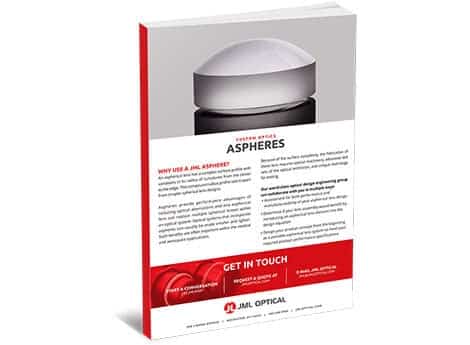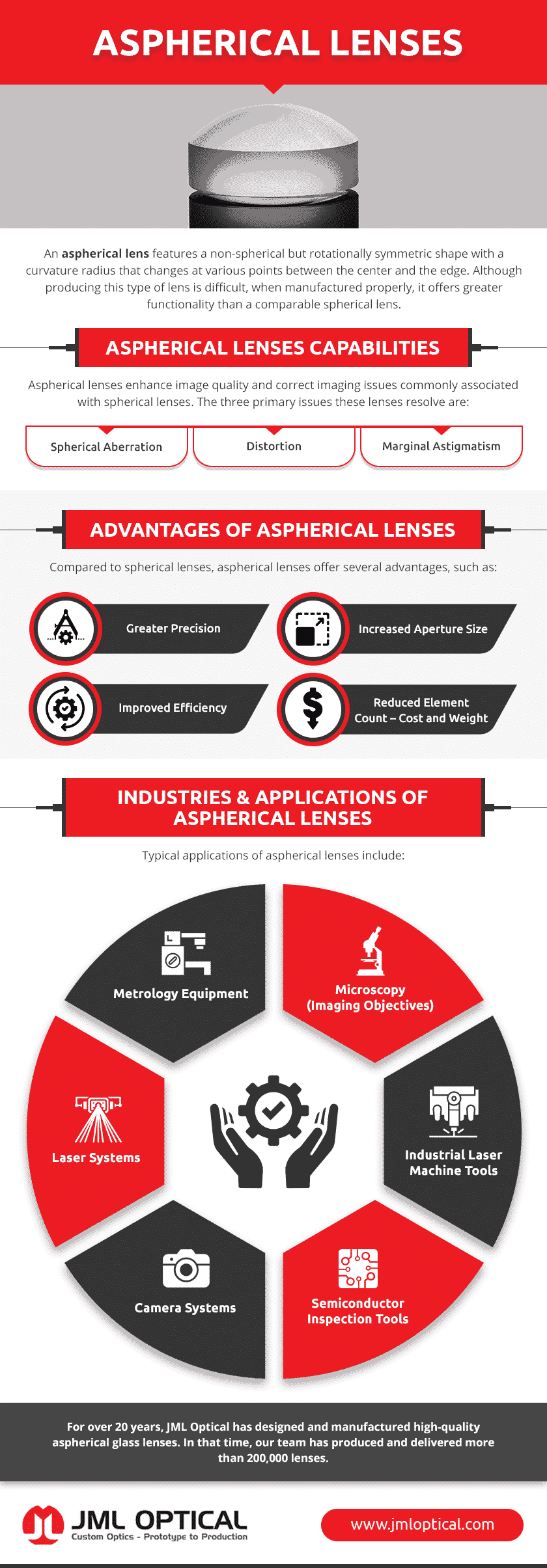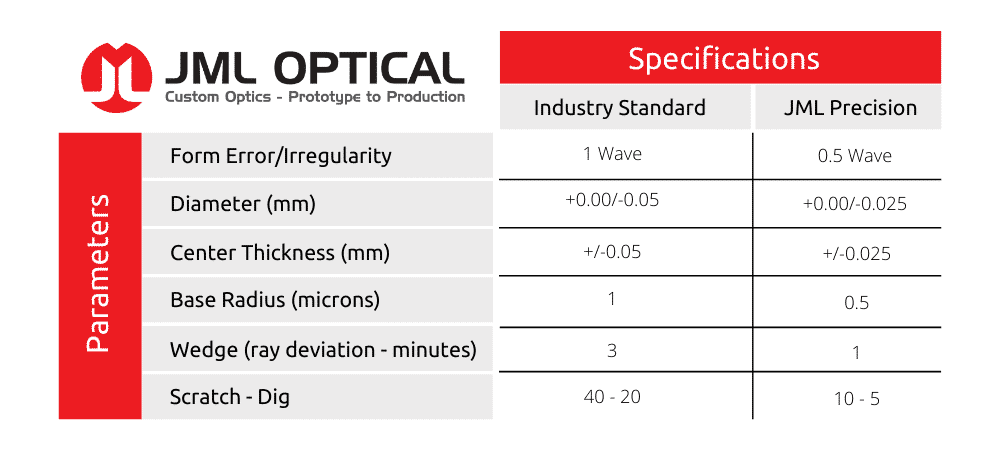Download Our Printable Guide To Aspherical Optics
This guide outlines the functionality, advantages and application examples typical of aspheric lenses, as well as an overview of aspheric optics fabrication and manufacturing.
The following page provides an overview of aspherical lenses, outlining how they work, their advantages and applications, and comparisons to spherical lenses.
Spherical Lenses vs. Aspherical Lenses
Spherical lenses have a spherical surface and the same radius of curvature across the entire lens. In contrast, aspherical lenses have a more complicated surface with a gradually changing curvature from center to edge. These design differences can reduce the number of elements in an assembly and result in thinner, lighter lenses.
How Do Aspherical Lenses Work?
Aspherical lenses enhance image quality and correct imaging issues commonly associated with spherical lenses. The three primary issues these lenses resolve are:
1. SPHERICAL ABERRATION
In a spherical lens, light focuses at different distances (depending on where it enters in relation to the edge of the lens), which creates blurriness and peripheral distortion. This phenomenon is known as spherical aberration.
Aspherical lenses can reduce or eliminate this issue, an ability that stems from their unique design, which features a shallower surface curvature angle. When light enters an aspherical lens, it focuses to a single point regardless of whether it enters, creating a clearer and sharper image.
2. Distortion
When spherical lenses magnify or minimize images, they can distort and bend lines viewed through them. As aspherical lenses can have lower power along the edge, they can reduce or eliminate the risk of pincushion distortion in plus lenses and barrel distortion in minus lenses.
3. Marginal Astigmatism
Marginal astigmatism refers to an unwanted power gain that occurs in spherical and cylindrical lenses when something is viewed way from the optical center. It contributes to the creation of images that are out of focus. Aspherical lenses avoid this by reducing power gain along the lens edge.
Advantages of Aspherical Lenses
Compared to spherical lenses, aspherical lenses offer several advantages, such as:
Greater Precision
Aspherical lenses focus can light into a sharp focus instead of a blurred spot of light. This design results in clearer images and improved collimation, making them suitable for use with laser diodes and other high-precision applications.
Increased Aperture Size
For applications that require high light throughput, aspherical lenses are an ideal solution. They accommodate increases to numeric aperture size without sacrificing image quality.
Improved Efficiency
Aspherical lenses correct optical issues that would otherwise take multiple spherical lenses to resolve. This characteristic allows industry professionals to replace complex multi-lens systems with a single aspherical lens, making the assembly simpler, smaller, lighter, cheaper, and more efficient.
The above advantages are some of the reasons that aspherical lenses are increasingly finding employment in high-precision applications, such as those found in the aerospace and medical industries.
Applications of Aspherical Lenses
Typical applications of aspherical lenses include:
- Cameras
- Collimation lens for laser beam profilers
- Eyeglasses
- Laser devices and equipment
- Optical communication network systems
- Pickup lenses for optical disks
Aspherical Lens Solutions From JML Optical
- Sizes: 10mm-200mm
- Material Types: all the optical glass, fused silica, and Zerodur™
For over 20 years, JML Optical has designed and manufactured high-quality aspherical glass lenses. In that time, our team has produced and delivered more than 200,000 lenses.
Armed with a recently expanded manufacturing facility equipped with state-of-the-art CNC machinery, we manage the entire fabrication process, from generating to grinding to polishing.
We also optimize manufacturing operations to reduce wait times, verify that quality standards are met and documented, and maximize production yields. Our production capacities accommodate rapid prototyping to volume production.
In addition to our fabrication capabilities, we provide the following services:
- Design assistance
- Design performance and manufacturability assessment
- Lens assembly optimization
To find out more about our aspherical lens offerings or discuss an upcoming project with one of our experts, contact us or request a quote today.




